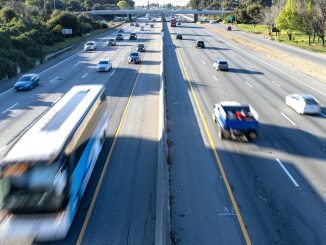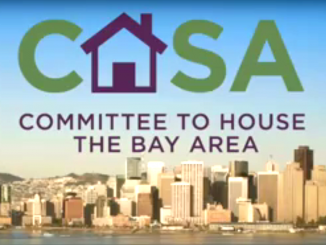
BY EMILY MIBACH
Daily Post Staff Writer
Sen. Dianne Feinstein, D-Calif., is pushing to have a new bridge constructed across the Bay, midway between the Bay Bridge and the San Mateo Bridge, in the hopes of alleviating congestion on those two bridges.
Feinstein, along with Congressman Mark DeSaulnier, D-Concord, sent a letter Wednesday (Dec. 6) to Metropolitan Transportation Commission (MTC) Executive Director Steve Heminger in support of the new bridge, which has been discussed for decades. Over the years, it’s become known as the “Southern Crossing.”
Their letter also says that MTC’s plan to put a $3 toll increase on the state-owned Bay Bridges won’t “come anywhere close” to reducing congestion on the Bay or San Mateo bridges.
Feinstein and DeSaulnier also want to put BART on the new southern crossing bridge.
“A new Bay crossing would alleviate traffic through San Francisco and the East Bay, would better connect the entire Bay Area, and would provide significant benefits to toll payers,” Feinstein and DeSaulnier wrote. This is not the first time Feinstein has called for the bridge. She called on MTC to look into a southern crossing in 1990 and 2000, according to Randy Rentschler, MTC’s director of legislation and public affairs.
“She’s talking about … (finding) a way to solve the experience most have with congestion and to support the jobs machine that is the Bay Area economy,” Rentschler said. “We have to do way more than what we have been doing.”

MTC looked into the southern crossing in 2012, where the bridge would connect Highway 238 in Hayward to Interstate 380 in San Bruno. The Hayward to San Bruno bridge, along with a BART tunnel, would cost up to $12.4 billion, according to a May 2012 presentation to the Bay Area Toll Authority.
Rentschler said while Feinstein’s wish for a southern connection is “compelling,” the bigger challenge is getting traffic to flow on either side of the new bridge.
According to the May 2012 presentation, at least 61,300 people a day would use the new bridge, and around 27,100 of those would be new transbay trips.
Adina Levin, who is on the Menlo Park Complete Streets Commission and runs the blog Friends of Caltrain, agreed with Rentschler’s sentiment.
She said that if there was another bridge, where would the cars from that bridge go? “(Highway) 101 is clogged, our streets are clogged, our parking is clogged,” Levin said.
Levin said reinstating the defunct Dumbarton Rail corridor — an abandoned rail line that goes from Redwood City to Menlo Park and then across the Bay on a run down railroad trestle — and improving the San Mateo Bridge are her alternatives to an entirely new bridge.
On Wednesday the SamTrans board approved the Dumbarton Corridor study, which is a plan that calls for increasing the frequency of buses across the current Dumbarton bridge and rebuilding the rail bridge for Caltrain or BART.
While Feinstein and DeSaulnier’s letter did not mention the Dumbarton Bridge, DeSaulnier said that both a southern crossing and reinstated rail bridge ought to move forward.
“Rehabilitating the Dumbarton rail corridor is an important project, but it does not supplant the need for a second Southern Crossing. Rehabilitating the Dumbarton bridge and the building of a Southern Crossing address the need for whole system transportation improvements in the Bay Area. We should be looking at both projects, with an eye toward moving as many people as possible, as quickly as possible,” DeSaulnier said in an email to the Post.
While the Dumbarton revamp is in the beginning stages, it’s not clear whether the MTC will be looking into the southern crossing because it was studied five years ago.
Rentschler said while it’s good Feinstein is giving the MTC a “vision,” he warns those in support of the bridge against getting “locked down” into supporting a single issue, saying those who want to see better Bay Area traffic ought to look at, and advocate for improving the entire system.



